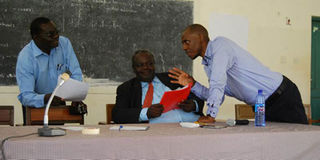School recruits community teachers to fill staffing gaps

Appeal. Twaweza research coordinator Julius Atuhurra (Right), Dr John Bwayo (Centre) and Mr Moses Wambi from Bishop Willis Core PTC during a validation exercise in Iganga last month. PHOTO BY PHILIP WAFULA
What you need to know:
- Target. The recruitment targets Senior Four and Six leavers and the placement takes immediate effect.
- It was noted that between 2011 and 2016, some schools in Busoga sub-region consistently performed poorly in the PLE and in some schools, while the performance in specific subjects was consistent, others had two subjects consistently poorly done. The objective of the exercise was to introduce PD, validate the findings conducted last year and motivate all schools to take the concept back to the community and improve on learning outcomes.
Iganga. A government-aided primary school in Bugiri District has turned to the community for teachers to solve staffing challenges.
Mr Wilfred Obbo Ochola, the head teacher of Kayango Primary School, brought the unconventional approach to the fore during a positive deviance validation exercise held at Bishop Willis Core Primary Teachers’ College (PTC) in Iganga District recently.
According to Mr Obbo, the recruitment targets Senior Four and Six leavers and the placement takes immediate effect.
“Whenever we begin a new term, we analyse our performance vis-a-vis staffing and once we realise that we have a gap in a particular subject, we immediately start the process of filling it,” he said.
The interviews
“The applicants are examined in the subjects they seek to teach. For example, if a Senior Four leaver wants to teach Science, he or she is given a past Science Primary Leaving Examination (PLE) paper to do in one hour and it is marked. The pass mark is 85 per cent across all subjects,” Mr Obbo said.
“Successful candidates are taken on a month later and are paid Shs100,000 monthly, which comes from the Parents’ Teachers Association (PTA) coffers though the figure has since been increased to Shs130,000 per month.”
Mr Obbo recounted a moment the school only had 12 teachers instead of 18, with him being the only Mathematics teacher yet he also had to man the administrative docket.
“We sought just one Mathematics teacher from the community but many people applied,” he said.
He added: “We have so far recruited three community teachers over the past two years who have since upgraded, with one being conscripted into the police force before opting to join the prisons service.”
“Our recruitment is academic-oriented. As long as someone has sat for Senior Four or Senior Six, passed and then passes our internal interviews, we take them on unlike the District Service Commission recruitment which is profession-oriented and focuses on professional ethics, qualifications and others,” he said.
Mr Obbo, who credited a former deputy Resident District Commissioner (RDC) he did not name for the idea, said the school currently has 18 teachers who include 16 directly posted by the District Service Commission and plus two community teachers.
“This man (the former deputy RDC) came to Bugiri to analyze our performance and took all head teachers of primary schools to Fort Portal for three days, which were spent visiting schools in that area,” he recalls with nostalgia.
The validation exercise, conducted by Twaweza, a regional Civil Society Organisation that focuses on education governance, was in response to government’s rebuttal regarding the assessment of learning outcomes in primary schools.
“One way in which such assessment could be made was through Positive Deviance. Here, we look for schools and teachers who, despite their difficult circumstances, make a positive contribution to children’s learning,” Mr Julius Atuhurra, Twaweza East Africa regional research coordinator, said.
Challenges
It was noted that between 2011 and 2016, some schools in Busoga sub-region consistently performed poorly in the PLE and in some schools, while the performance in specific subjects was consistent, others had two subjects consistently poorly done. The objective of the exercise was to introduce PD, validate the findings conducted last year and motivate all schools to take the concept back to the community and improve on learning outcomes.




